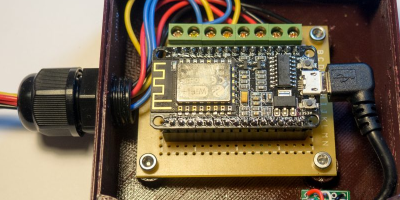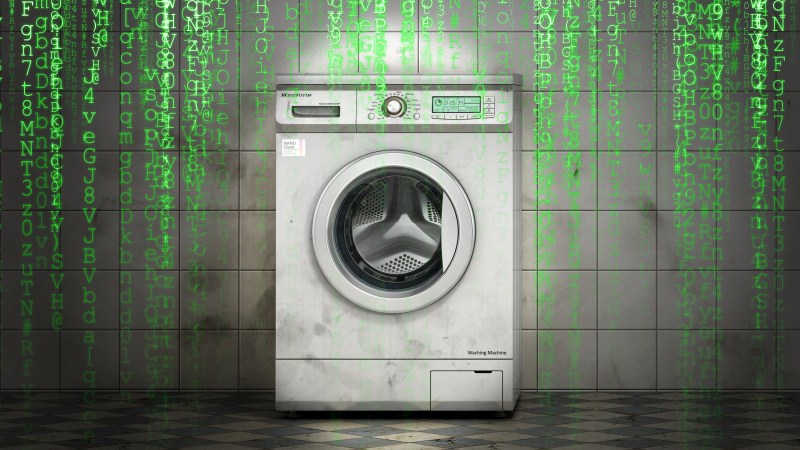When you think of world-changing devices, you usually don’t think of the washing machine. However, making laundry manageable changed not only how we dress but how much time people spent getting their clothes clean. So complaining about how laborious our laundry is today would make someone from the 1800s laugh. Still, we all hate the laundry and [Andrew Dupont], in particular, hates having to check on the machine to see if it is done. So he made Laundry Spy.
 How do you sense when the machine — either a washer or a dryer — is done? [Andrew] thought about sensing current but didn’t want to mess with house current. His machines don’t have LED indicators, so using a light sensor wasn’t going to work either. However, an accelerometer can detect vibrations in the machine and most washers and dryers vibrate plenty while they are running.
How do you sense when the machine — either a washer or a dryer — is done? [Andrew] thought about sensing current but didn’t want to mess with house current. His machines don’t have LED indicators, so using a light sensor wasn’t going to work either. However, an accelerometer can detect vibrations in the machine and most washers and dryers vibrate plenty while they are running.
The four-part build log shows how he took an ESP8266 and made it sense when the washer and dryer were done so it could text his cell phone. He’d already done a similar project with an Adafruit HUZZAH. But he wanted to build in some new ideas and currently likes working with NodeMCU. While he was at it he upgraded the motion sensor to an LIS3DH which was cheaper than the original sensor.
[Andrew] already runs Node – RED on a Raspberry Pi, so incorporating this project with his system was a snap. Of course, you could adapt the approach to lots of other things, as well. The device produces MQTT messages and Node – RED subscribes to them. The Pushover handles the text messaging. Node – RED has a graphical workflow that makes integrating all the pieces very intuitive. Here’s the high-level workflow:
You might wonder why he didn’t just have the ESP8266 talk directly to Pushover. That is possible, of course, but in part 2, [Andrew] enumerates some good reasons for his design. He wants to decouple components in the system for easier future upgrades. And MQTT is simple to publish on the sensor side of things compared to API calls which are handled by the Raspberry Pi for now.
Laundry monitoring isn’t a unique idea and everyone has a slightly different take on it, even some Hackaday authors. If phone notification is too subtle for you, you can always go bigger.
















Does it use a needlessly complex framework?
Do I have to installed Framble to compile Bramble, to enable Druffle to fluffle the socksifier?
What the IoT has taught me, is that unless you have 100’s of Mbs of crapware, your IoT device is crap.
Does it require a desktop to be running, or a huge AWS server infrastructure that can snarf my data?
It took me longer than I’d care to admit to determine if your second line was talking about real APIs or not. Especially since “socksifier” is apparently a real thing:
https://github.com/numaru/socksifier
And that’s the whole beauty of the comment. I should make a webpage, “guess if it’s a framework, or nonsense”.
I now have to register a dryer api, and call it “fluffle”, it may or may not exist already.
Can we have a gameshow? Framework or Cybercurrency? We give you 10 names and you decide if they are an API or a cryptocurrency.
..or both, or not…
Or perhaps Schrödinger’s argot. The answer doesn’t exist in one state or the other until you guess.
fluff.ly
on second thoughts maybe don’t google that
I understand your point but node-red and a mqtt broker can run on a RPi zero W easily and it can all by configured through a webpage node red generates. If you compile your own esp8266 code you can also handle most of the programming on the server side. The bill of materials is less than $30 if you include a SD card and the list of things you need running is like 3. Less if you use peter scargills “the script” which includes all the stuff and you dont have to install anything else.
I will not let the NSA sniff my dirty undies!
Disturbingly, this implies that you are OK with it as long as it is not the NSA. ;-)
Denying the antecedent
I would have said “The Man” but that sounds so last millenium.
“I will not let the NSA sniff my dirty undies!”
They can sniff mine all they want, it would serve them right!
B^)
Eevery washing machine locks its door when in service. Just checking the state of the solenoid would do so as much as an accelerometer is a good idea it is not mandatory.
Even more, nearly all not so old washing machines uses I2C/SPI LCD for status messages and mode indication, so it is stright-forward solution to hijack LCD data, parse it and send where you want over Ethernet or WiFi as email, syslog, xmpp, whatever… in few lines of plain C code running over, say, ESP8266 firmware. However, this does not involves all that damned clouds, javascript frameworks on frameworks on frameworks, IoT buzzwords, BigBrother online services and other useless and unnecessary bullshit, that’s why that good, simple and clean solution will be immidiately discarded by modern would-be hackerish hipsters censorship.
“Every washing machine locks its door when in service.”
No. Top-loading machines don’t.
Yes they do. At least in Europe.
Top loading machines in the US. Here in Europe; since the second world war; EVERY washing machine/dryer locks its door while washing. Thats simply mandatory.
My parents have a new one that does, but my 90’s Sears special definitely doesn’t lock. I’m surprised it stops spinning when the lid is open.
In that case, is even easier there will probably be a circuit to check if the door is open or not.
Our previous Top-loader did not, but our current one does. The old one was from 2007, the new one from 2019.
And internally, they are almost identical – I specifically bought one that was similar to the old one (as I’d spent a pile of time working on the old one and knew it pretty well, inside and out)
I’d say there’s not hard and fast rule about this. As far as I know, there’s no law that says washers need to lock their lids/doors. I’d be interested to know if some company dealt with some litigation though – that’s where I imagine most of this stuff comes from.
“LET THE ESP8266 WATCH YOUR DIRTY DRAWERS GET CLEAN”
Insert dresser. Pressure wash drawers.
I just used a Sonoff POW with Tasmota to notify our home server (via syslog to the server’s rsyslog), which in turn notifies my phone.
This is almost an electronic Rube Goldberg machine – you could simply set a countdown timer on your phone to know when it’s done ;) Makers gonna make
I built my wash-is-done-inator (https://hackaday.io/project/43887-the-wash-is-done-inator) exactly because it was a pain to set a timer every time that I started the washer. The washing machine *is* already a timer; why do I have to set a second one? It’s an off-task annoyance and I’d rather that the washing machine just did a better job of notification.
Our washing machine won’t advance the timer until the water has reached the selected level, with our water pressure varying between 22 and 60 psi, and the tub needs to be filled twice (wash and rinse cycles) a phone timer won’t be accurate.
Implies you remember to set timer. If I could always remember to set a timer, I’d probably always remember to just check on my washer. But I don’t.
Sometimes when I’m loading the washer, I don’t have my phone with me. (Skivvies don’t have pockets)
I did a similar thing but using a light sensor taped over the done led. I used ifttt to trigger the email. I will admit my solution is a hack, but it was simple and worked
Struggling already since a while to get the vibrations detected… Either there are too much false events detected (when not washing) or nothing is detected when the machine is running. Any advice?
For testing purpose I outputted the raw data of the X, Y, Z. These values almost doesn’t change… Any idea?